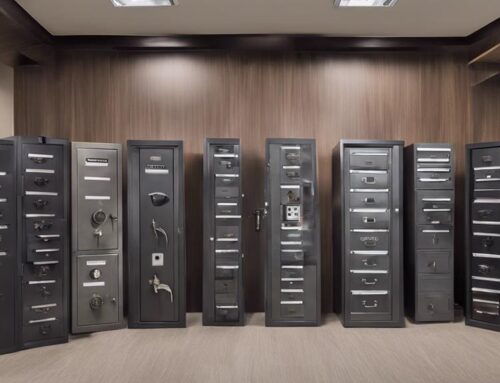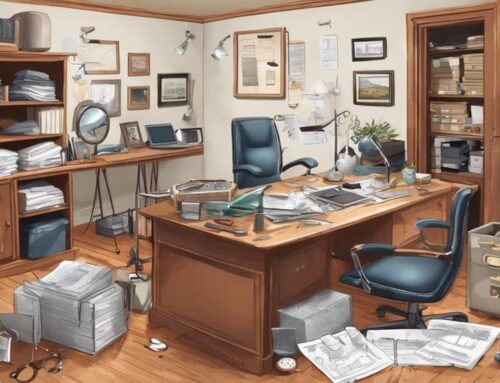When it comes to keeping your valuables safe, the location of your safe plays a crucial role. It’s essential to choose the right spot to deter potential thieves and protect your belongings. In this article, we explore the five best and worst places to install a safe in your home.
By bolting your safe to the ground, you can add an extra layer of security. We’ll also discuss the challenges of moving a heavy gun safe upstairs and the security of floor safes.
Stay tuned to find out where you should and shouldn’t place your safe for maximum protection.
Ideal Locations for Safes
The wall behind a painting or mirror conceals the safe from sight, making it difficult for thieves to access, and can be bolted to the wall for added security.
Wall mounted safes offer numerous benefits and advantages for those seeking to protect their valuables. By hiding the safe behind a painting or mirror, it becomes virtually invisible to potential burglars, increasing the security of your belongings.
Additionally, wall mounted safes can be easily installed and secured to the wall, providing an extra layer of protection against theft. This type of safe not only provides a secure storage option, but it also blends in with the room decor, giving you the freedom to choose a location that suits your style without compromising on safety.
Security of Floor Safes
Properly installed floor safes offer a higher level of security against theft. The advantages of floor safes are numerous.
Firstly, they are concealed from view, making them less likely to be targeted by burglars. Additionally, floor safes are difficult to remove, as they are securely bolted to the floor. This adds an extra layer of protection against theft, as criminals would need to spend considerable time and effort to access the safe.
When installing a floor safe, there are a few tips to keep in mind. First, choose a location that is easily accessible for the owner but difficult for thieves to discover. It is also important to ensure that the safe is properly secured to the floor, using high-quality bolts and anchors.
Moving a Gun Safe Upstairs
Moving a heavy gun safe up interior stairs requires careful preparation, such as using electric dollies or traditional dollies. Here are three key steps to successfully move a gun safe upstairs:
- Prepping the staircase: Before attempting to move the safe, it is important to prepare the staircase. This can be done by covering the stairs with a protective material to prevent any damage to the surface. Additionally, clearing any obstacles or clutter along the path will ensure a smooth and safe transfer.
- Using electric dollies: Professional safe movers often rely on electric dollies to transport heavy safes up the stairs. These dollies are equipped with powerful motors that make the task easier and more efficient. They are designed to handle the weight and size of a gun safe, reducing the risk of injury or damage.
- Traditional dollies: If electric dollies are not available, traditional dollies can also be used. These dollies typically have two wheels and a platform to support the safe. By carefully maneuvering the safe onto the dolly and using proper lifting techniques, it is possible to move the safe up the stairs with relative ease.
Reasons to Bolt a Safe to the Ground
Bolting a safe to the ground adds an extra layer of protection against theft, making it harder for criminals to remove it. This is especially important when considering the benefits of floor safes.
Professional safe installation is crucial to ensure the safe is securely bolted and properly positioned. Floor safes offer a higher level of security as they are concealed and difficult for thieves to locate. However, without professional installation, even the toughest floor safe can be illegally removed by determined criminals.
By hiring a professional, individuals can rest assured that their floor safe will be installed correctly, making it impractical for thieves to access the bolts securing the safe to the floor.
Protecting one’s valuable possessions requires not only the right safe but also the expertise of a professional safe installer.
Worst Locations for Safes
The basement is easily searched by thieves and poses an increased risk of moisture damage. Storing a safe in this location may not provide adequate security for valuable items. Additionally, the potential dangers of moisture damage can compromise the integrity of the safe and its contents.
On the other hand, installing a safe in the attic can have hidden benefits. While it may be difficult to access for both the owner and potential thieves, the concealment of the safe depends on clutter and disorganization. Careful placement in the attic can help maintain security. However, it is important to note that limited access to the safe and the possibility of being incidentally targeted during a search should be considered when choosing this location.
Frequently Asked Questions
What Are the Benefits of Bolting a Safe to the Ground?
Bolting a safe to the ground offers advantages such as making it harder for thieves to remove and carry away the safe. It adds an extra layer of protection against theft and ensures the security of valuable items.
How Can a Gun Safe Be Moved Upstairs?
Moving a gun safe upstairs requires careful preparation. Covering the staircase prevents damage. Professional safe movers use electric dollies or traditional dollies. Additional preparation may be needed for stairs with pivots. It can be a painstaking process.
Why Are Floor Safes Considered More Secure Against Theft?
Floor safes are considered more secure against theft because they are difficult to remove without damaging the surrounding floor. Additionally, accessing the bolts securing the safe is impractical without opening it, adding an extra layer of protection.
What Are Some Ideal Locations for Installing a Safe in a Home?
Ideal locations for installing a safe in a home include: wall behind a painting or mirror, floor of a closet, inside a piece of furniture, buried in the backyard, and inside a false electrical outlet.
What Are Some of the Disadvantages of Placing a Safe in the Basement?
Placing a safe in the basement can have disadvantages. It’s easily searched by thieves, increases the risk of moisture damage, and may not provide adequate security. Wall safes, on the other hand, offer benefits like concealment and added security.


